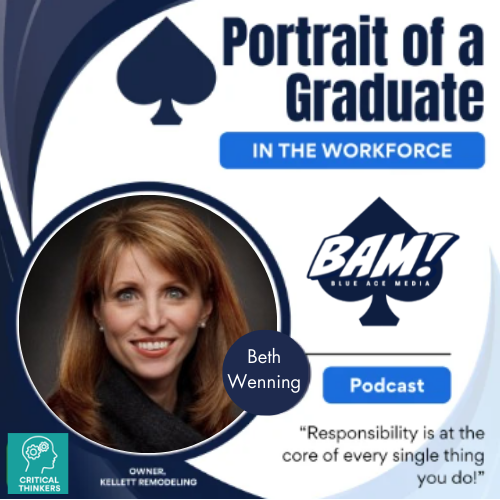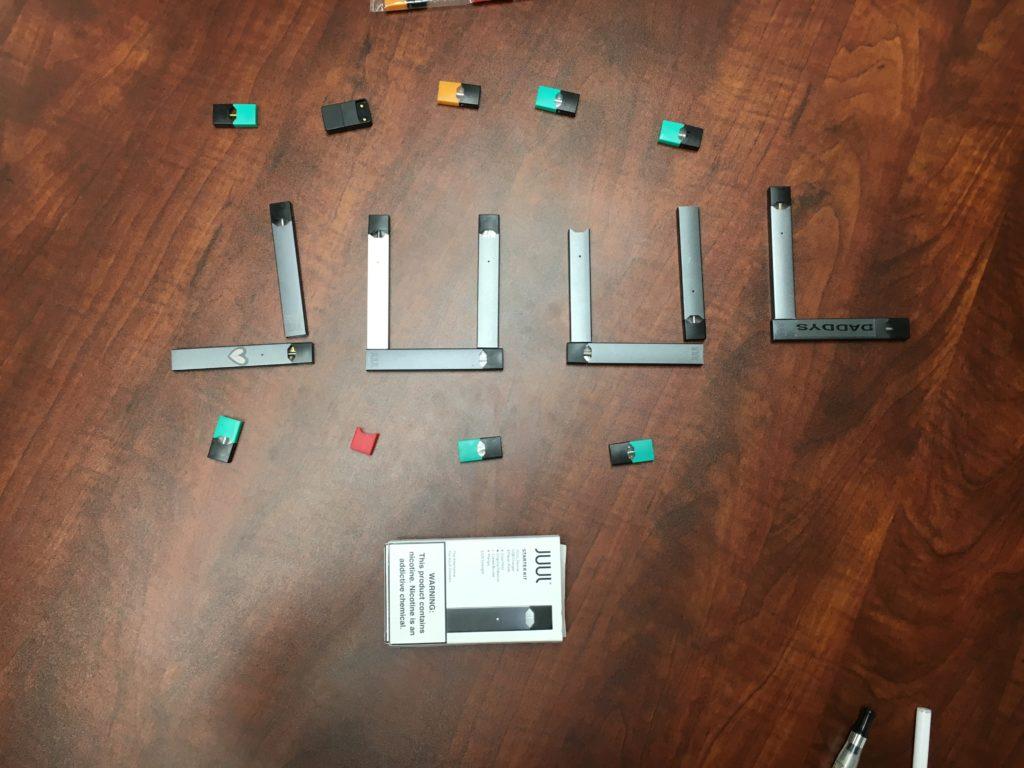BY ANDY HOBEN (’20) AND JASON REDING (’19)
“It’s an e-cigarette that appeals to minors.”
“It’s a vape that looks like a flash drive.”
“It is a nicotine box mod.”
“It is a small, sleeker version of bigger nicotine devices.”
Today, teens are attracted to these compact, powerful devices that contain the addictive qualities of a pack of cigarettes. These devices are called JUULs, and they are infiltrating the minds of young people as well as the places they inhabit, like schools.
According the Partnership for Drug-free Kids, vaping is “the act of inhaling and exhaling aerosol or vapor produced by a vape device.” These devices contain 4 basic components: a cartridge or tank to hold the vape liquid, a heating element, a battery and a mouthpiece to inhale. Vaping devices come in many shapes and sizes, with some resembling a cigarette shape, a pipe, a mobile phone, or in the case of the JUUL, the device most popular among teens, a thumb drive.
[tribulant_slideshow gallery_id=”58″]
These devices are revolutionizing the smoking market not only in the way they look, but in what is contained inside of them. As opposed to the typical cigarette flavoring and smoke, the new vape devices actually use a flavored water vapor that can come in thousands of varieties, from fruit to mint to bubble gum. They also contain varying levels of nicotine, a highly addictive substance that contains psychoactive qualities. These levels range from 2 mg/ml to 59 mg/ml; the JUUL is on the high end, at 59 mg/ml of nicotine in each pod, the equivalent to a pack of cigarettes. These features are making these devices increasingly appealing to young people.
“JUUL packs so much nicotine into that little cartridge that kids can get an almost-high feeling because of all of the nicotine,” school nurse Ann Varrasso said.
These factors are what is making JUULS so appealing and prevalent within school age kids. In the 2017-2018 “State of the School” report, polls that collect information on student thoughts and habits, 25.5% of twelfth grade students and 20.4% of 11th grade students reported to using an electronic vapor product within the last 30 days. While JUULs have a stated purpose of being a healthier alternative to cigarettes for adult smokers, these numbers show that they have infiltrated the lives of minors, which is a major concern for the school district.
“I know a lot of people attempt to use e-cigarettes to get of real cigarettes, which I can appreciate… the problem I have is when you are underage, you can’t smoke cigarettes, so you can’t smoke e-cigarettes either if you’re not 18”, vice principal Scott Carpenter said. “They aren’t addicted to cigarettes, so I don’t know what the attraction is. I do know that the motivation of the companies that own the e-cigarette properties is their gateway to get them addicted to nicotine.”
JUULs have even become an issue within the actual school building. When asked if he has witnessed students vaping in school, one student said “You can’t really go into the bathroom without seeing a JUULing tournament… I think it’s a really big problem at our school and that we should work on it.” One student said “I have experienced people in the bathroom juuling, and it is really frustrating.” In fact, in a random polling of students throughout a normal school day, 10 out of 10 students that were asked if they had seen or heard of students JUULing during the school day said that they indeed had. The JUUL problem has even extended into the actual classroom.
“I have personally had students I know in class that have JUULed,” health teacher Karly Worrall said. “It is shocking and sad that students are so addicted that they have to do it in class and that students try to be that rebellious.”
With the discrete nature of JUUL use, being that it is hand held, easily concealable, and emits and odorless vapor, it can be hard to spot. “Students are addicted to the nicotine or the rush… it is as simple as sleight of hand blowing of the vapor into a sleeve or facedown on a desk,” Worrall said.
The nicotine policy at the school includes strict repercussions for those that get caught using on school property, including suspensions. However, this has not necessarily deterred students from trying, a major concern for school administration.
“The fact that we have students in the building that can’t get through a 6 hour day without doing it during the school day lets me know that there is probably an addiction issue that they are willing to risk 5 days of in school suspension,” Carpenter said.
But, even besides administrative consequences, the negative effect of JUUL comes down to 3 main factors, according to Carpenter: addiction, cost and health issues.
“I think the first thing that they have to worry about is the whole addiction piece,” Carpenter said. “It contains nicotine, which is one of the most addictive substances that we have. So I think that goes along with the addiction piece, the idea of needing something to get you through the day.”
Next is the cost issue. JUULs are not cheap, as a starter pack is around $50, containing the actual device as well as 4 juice-filled pods, and additional pods cost around $5 per 200-puff cartridge.
“They are not cheap,” Carpenter explained. “So you are running into a habit that is very costly.”
“I remember friends of my parents decided to stop smoking… when they stopped smoking, they had saved up enough money to buy a boat. They had a boat payment that was normally being spent on cigarettes,” Carpenter said.
“If you think about the lack of logic in that, I think it is pretty easy to see.”
The third, yet arguably the biggest long-term consequence of using the JUUL, are the life-long health effects. Because of the fact that JUUL has only been in business in the last 5 years, the health concerns are uncertain; however, speculation on what the effects could be is nothing short of alarming.
““We don’t know yet,” Varrasso explained when asked about the health concerns of JUUL. “I’ve read some concerns because it is such a wet fluid, or a wet inhalation, so they are worried what is going to happen to the lungs… because you are creating such a wet atmosphere in there, I know they are waiting and watching to see what that is going cause, like possibly lung disease.”
Carpenter shares a similar concern.
“I don’t think we fully know what e-cigarettes are doing from a health standpoint,” Carpenter said. “I know that there has been research out there about the amount of metal particulates that your lungs are absorbing because of the temperature that its reaching, and when I hear metal particulates going into lungs, that’s probably not gonna help your health down the road.”
In short, though research of the effects of JUULs is inconclusive, it is still a concern for school administration and a high priority.
“I think there is the mental addiction concern, there is the financial concern, and then there is the physical health concern as well.”













































